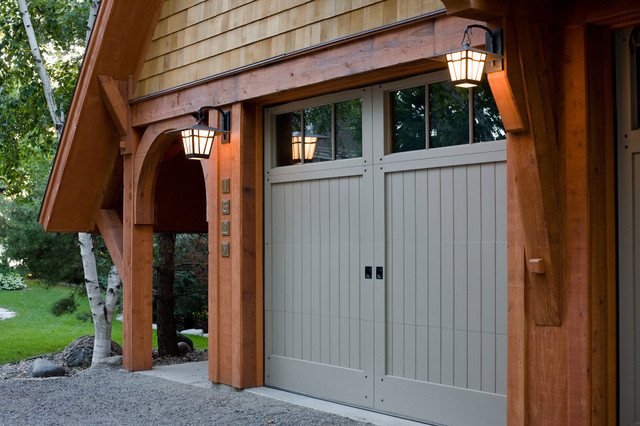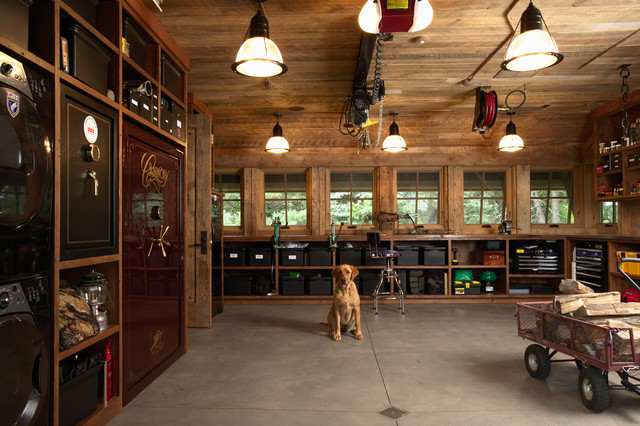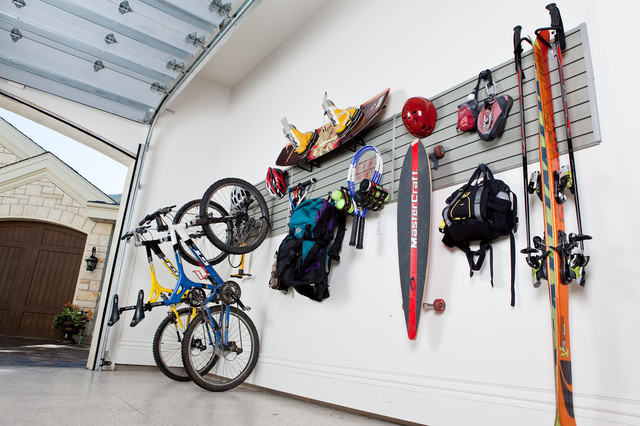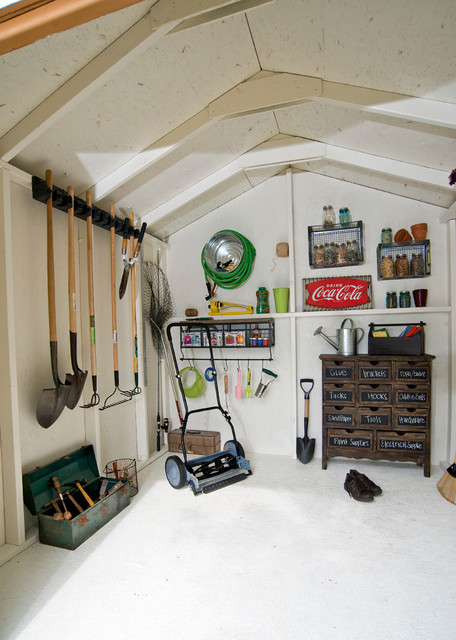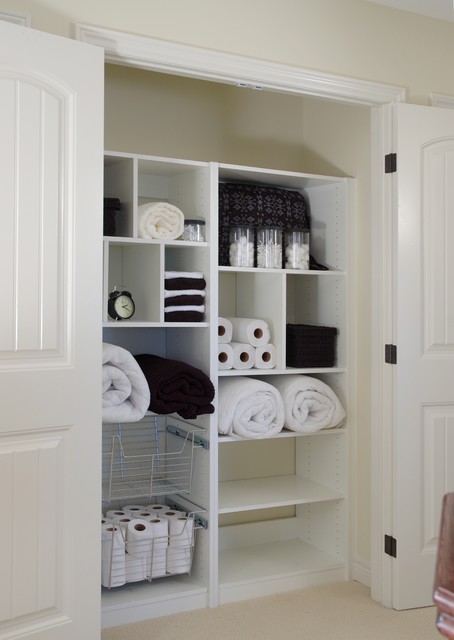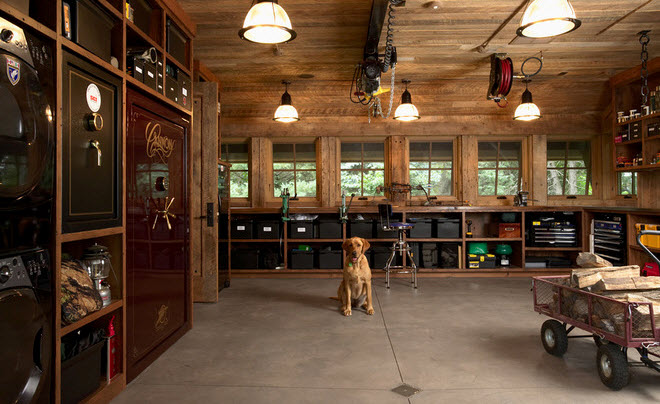
Finally Clean Out Your Garage in These 8 Steps
Jul 21, 2017
Around the House Tips
11 minute read
By Jeanne Taylor, Houzz
On my street, every home has a two-car garage. Yet hardly any of the garages are used to park two cars. Even fitting one car in the garage is a stretch for many of my neighbors. Because let’s be honest: It’s pretty common for the garage to turn into a home’s dumping ground.
Often, people stash something in the garage because they can’t decide what else to do with it. Frequently, these stashed items are rarely used. In some cases, they’re never used. Many of us simply own too much stuff and tend to use our garages as storage units, which works as long as you have adequate driveway or street parking. But if you are downsizing to a condo, loft or apartment, you may no longer have the luxury of expansive garage space. Here’s how to seriously downsize the belongings in your garage in anticipation of a move — especially into a smaller home.
What to Do Before You Start
Schedule time on your calendar. If you’re moving, you may already have a long to-do list. Think about adding the garage to your list and even putting a specific time on your calendar to attack this assignment. In my experience with clients, getting rid of belongings in the garage is a time-consuming job, so I recommend you think in terms of days rather than hours. Also, if you already know where you will be moving to, it’s a good idea to measure the dimensions of the new storage space so you have a feeling for how much you need to discard.
Assess your resources. What resources do you need accomplish this task? For your first step, you might look into ordering a dumpster from your local waste management company to dispose of unwanted items and trash. Also, consider researching charitable organizations that can pick up belongings you decide to donate. A list of consignment stores to sell household items to is another great option. If you have more time and are comfortable doing so, you might consider selling more expensive items on Craigslist or eBay. Finally, you might research a local resource where you can dispose of old paint, pesticides, motor oil and other toxic substances as well as electronic waste. These items cannot be placed in a trash or recycling container.
Collect boxes, packing supplies and large trash bags. A local grocery store or pharmacy is a good place to find free cardboard boxes, and many stores are happy to part with them. Craigslist can be another source for used boxes; people often give boxes away for free after they’ve moved. If you prefer new moving boxes, you can purchase them at a local home improvement store or order them online.
How to Run Your Garage Purging Session

Need to Replace or Repair Your Garage Door?
Clear some space and mark off zones. To keep your job organized, you might want to create as much empty space as possible in the middle of the garage floor. Consider moving the car and other large, bulky items, such as the lawn mower and bicycles, out of the garage. I suggest dividing the garage into six sections: donate, sell, toss, keep, return to someone else, and undecided. You can mark off each section with blue painter’s tape or colored chalk. It is helpful to save room on the floor for a staging area where you can place all items from one category before you make any decisions.
Work on one category at a time. I recommend picking a category, perhaps holiday decor, and then pulling every item from that category out of hiding and placing it in the staging area. Don’t forget about belongings stored in the rafters. Try to make a decision on each item in your category before moving on to the next one. If you really can’t decide, place the item in the “undecided” pile. However, try not to put too much in this pile, because it will only delay the decluttering process.
Expect sorting of family members’ items to go slower. Children who are grown and have permanently moved out of the house often think of their parents’ home as a storage unit. This also can be true for an ex-spouse who has moved out of the family home. You are unlikely to have room to store other people’s belongings in your smaller space. Unfortunately, dealing with other family members can sometimes be emotionally taxing. Because of that, I recommend you tackle these items last. That way, you can plow full steam ahead on culling your own belongings and not let any potentially difficult conversations slow you down.
Keep your goals in mind. If you have trouble making decisions to let go of some items, it can sometimes be helpful to envision your new uncluttered space. To quote Marie Kondo’s best-selling book The Life-Changing Magic of Tidying Up, only keep items that “spark joy.” If you don’t truly love something or actually need it then, it is time to bid it goodbye.
Below are some common categories you might be tackling, as well as suggestions on what to keep and what to let go.
1. Sports equipment, camping gear, beach chairs and old bikes. Move all sports-related items into your staging area and take a serious look at the things in this category, considering whether you will ever use them again. Yes, it was fun to go camping when the kids were young, but do you really plan to go again? Although I love to be outdoors in a beautiful natural setting, at this stage of my life I also love to retreat to a comfortable bed at night. The same goes for bikes, beach chairs, golf clubs, tennis rackets and ski equipment. Try to remember the last time you used each item. If you golf twice a month, then by all means keep your golf clubs. If the last time you used your clubs was in the late 1980s, it might be time to let them go.
Sports equipment, bikes and camping gear are popular items left behind by family members who have moved out. If that’s the case in your home, take all these items and move them to the “return to someone else” section of your garage. Set a time when the belongings can be retrieved. If family members live out of the area, send pictures of the items and ask them whether you can get rid of them. Consider setting a date for the family members to pick up their belongings they decide to keep.
2. Holiday decor. Many of my clients have collected multiple boxes of holiday decor over the years. This is especially true for people who have raised a family in a large home. Fortunately, holiday decor is often relatively easy to part with since it is in storage much of the year anyway.
As you go through these possessions, picture the home you will be moving into. Will there be any outside space to decorate, or will you be moving into a condominium or apartment building with little outdoor surface? Also consider decorations for holidays such as Easter, Independence Day and Halloween. If your kids are grown, do you still decorate for these holidays?
I encourage my clients to free themselves first of large, bulky items that are difficult to store. Then think in terms of duplicates. For instance, do you really need five manger scenes or six menorahs? Think about the size of your new space and decide whether you will be paring down the size of your Christmas tree. This may be the time to free yourself of an overabundance of ornaments and only keep the ones you really love. For those you decide to keep, I recommend purchasing an ornament storage box at a local home store. As you sort, you can place the keeper ornaments in the box (or boxes) so that they’ll be ready for the next holiday season.
3. Suitcases, tote bags, book bags and backpacks. For some reason, I often find old suitcases, tote bags, computer bags and backpacks stored in client garages. Your children may have played sports growing up and received a new backpack every new season. Some people have a hard time discarding an almost-new backpack every year. The same can be said for people who collect computer and tote bags from trade shows. Over the years, this free stuff can get out of control.
Reflect on whether these items are adding value to your life and realistically think about the storage capacity in your new home. I recommend saving only the items you have used over the last year, as well as suitcases you use when you travel. Then donate the rest so that someone else will be able to use them.
4. Gardening supplies. Ask yourself the following questions when deciding which gardening tools to keep:
- Will you have a yard in your new home?
- Will you be responsible for yard maintenance or will a homeowners association be doing it for you?
- Will you have a lawn?
- Do you even like gardening?
- Will you be hiring a gardener?
If you will not have a yard or if someone else will be doing your yard work for you, feel free to donate your gardening supplies and lawn mower. If you will have a small balcony or patio where you can have containers, consider keeping a few small items such as a trowel, weeder and gardening gloves.
5. Old shoes. Old and worn shoes often find their way to garage storage. My clients tell me they purchase a new pair of running shoes, hiking boots, snow or rain boots, and athletic shoes and put the old ones in the garage. They usually never get around to discarding old shoes, so the collection can become quite large.
You may want to think seriously about disposing of the unused footwear. It might be worth keeping one extra pair of running shoes if you work out in bad weather. That way, you’ll have a spare pair if one gets wet. Otherwise, I would recommend tossing all old shoes.
6. Unwanted household items. Unused furniture, out-of-date framed prints, abandoned craft projects and grandma’s china are all items I have unearthed in the dark recesses of my clients’ garages. Placing these items in the garage may be a way of putting off the decision to get rid of them. But the fact is, your new smaller home may not have enough storage space to house these items.
To discard these items, I suggest bringing them to a local home consignment store or, if you have more time, attempting to sell them on eBay or Craigslist. If you are in a time crunch, you may want to call a charity that can send a truck to pick up your unwanted belongings. Do keep a receipt and an itemized record of your donations for tax purposes. Goods donated to charity are tax-deductible.
7. Warehouse-size household products. Downsizing to a smaller space is a good time to think about whether you want to stop buying toilet tissue, paper towels, laundry soap and cleaning products at warehouse stores. Products from these stores come in large sizes that take up an inordinate amount of garage real estate.
It’s possible that you’re downsizing because your children have moved out. Therefore, you probably don’t go through as much laundry soap and toilet tissue as you used to anyway. Consider using up your stash, then buying normal-size products moving forward.
8. Old paint, motor oil, other hazardous waste and electronic waste. These items can’t be tossed in the garbage can, so check with your local waste management or trash service to see where you can dispose of these products. Some companies offer a once-a-year pickup of toxic and electronic waste, while others allow you to schedule a pickup. Some counties have a hazardous waste drop-off location where you can bring these toxic products. High schools and middle schools sometimes host electronic waste drives as fundraisers as well, and my homeowners association hosts a biannual electronic waste collection in the spring and fall. Check to see if your homeowners association provides a similar service.
Related Links:
Toss and Replace Worn Outdoor Furniture
You May Want to Keep Old Cherished Family Quilts
Up Next: The Basement
What part of your garage are you going to get cleaned up first? Let us know in the comments below!


